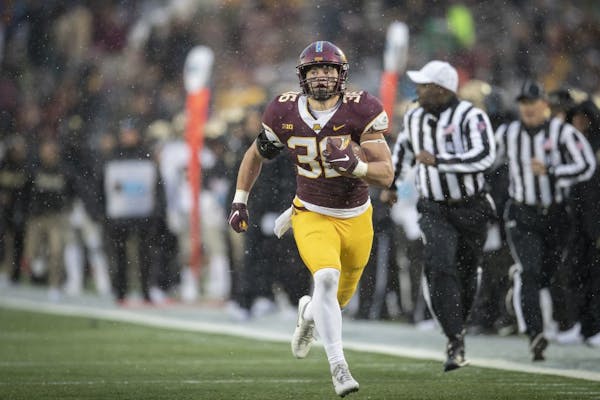Voluminous in scope and focused in nature, the Vikings' 2019 draft was perhaps unlike anything they have put together in the 13 years Rick Spielman has had either full or shared control of the roster.
For the first time since 1965, the Vikings used their first four picks on offensive players. They didn't select a defender until the fifth round, when they tabbed USC linebacker Cameron Smith with the 162nd overall pick. After spending a first- or second-rounder on a defensive back in three of the past four drafts, they waited until the sixth round to select one this year, taking Wyoming safety Marcus Epps with the 191st pick.
Their 12-player draft class — which included nine picks on Saturday and four in the seventh round alone — is the Vikings' largest since the NFL adopted its current seven-round draft format in 1994. The last time the Vikings drafted as many players in a year was 1991, when the NFL draft was still 12 rounds.
How the class of 2019 will be judged, ultimately, is on whether it accomplished the objective it apparently set out to achieve: Help the Vikings build an offensive identity around their $84 million quarterback.
The Vikings continued the initiative on Day 3 of the draft that they'd started on Day 1, taking Oklahoma guard Dru Samia in the fourth round and Elon tackle Olisaemeka Udoh in the sixth on Saturday after selecting North Carolina State center Garrett Bradbury in the first round. They drafted three offensive linemen for just the second time since Mike Zimmer became head coach in 2014.
In total, they used seven of their 12 picks on offensive players, adding Oregon receiver Dillon Mitchell and Colorado State wideout Olabisi Johnson in the seventh round on Saturday after selecting Bradbury, Alabama tight end Irv Smith and Boise State running back Alexander Mattison in the draft's first two days. The Vikings have reworked their offensive scheme this offseason around an approach that should be familiar to Kirk Cousins from his days in Washington, and their draft strategy — from the three linemen they took to the weapons they added — seemed focused on providing their quarterback with more resources.
"We need to be better on offense. That's where we needed the help," Spielman said on Saturday evening. "Our defense, we have, I think every starter back [other than Sheldon Richardson] and signed Shamar [Stephen] back [from Seattle after Richardson left]. We kept Anthony Barr, so we don't have a lot of defensive needs from a starter position. Offense was kind of a point of emphasis. We were never going to pass up a defensive guy if he's sticking that high on our board, and one of those guys would have fell. We're never going to not take the best player. But as we went down through the draft, I thought it fell very well for us on the players we did get on the offensive side."
The Vikings, who started the draft with eight picks, ended it with 12, trading down four times on Friday before moving up six spots on Saturday to select Samia 114th overall. They traded back one more time in the fifth round, ending the draft with a total of six trades that netted four extra picks.
Spielman said Cameron Smith could play at any of the Vikings' three linebacker positions and pointed out the importance of adding seventh-round cornerback Kris Boyd, who joins the team with college teammate Holton Hill facing a four-game suspension and Mike Hughes still returning from a torn left ACL.
But after the Vikings' second-half offensive swoon led to offensive coordinator John DeFilippo's ouster and the team missing the playoffs, a pivotal year for the organization figures to hinge on whether the Vikings' 19th-ranked offense can become more effective in 2019.
In Mattison, they added a running back they hope can make up for the loss of Latavius Murray as an inside runner. In Smith, they believe they've got the kind of athletic tight end they've fallen short of adding for several years (through a failed bid to sign Jared Cook in free agency and stalled trade talks with the Rams for Tyler Higbee a year ago).
Bradbury could start at center or guard, Samia could compete for playing time at guard and the 6-6 Udoh will likely get time to develop as a tackle of the future. And the Vikings' two new wide receivers were brought in to add options at a position that appeared thin behind Adam Thielen and Stefon Diggs.
"There's always an opportunity to snatch that No. 3 job, whether I am a rookie or it's one of the other guys," Johnson said. "I know you have [Laquon] Treadwell and guys like that, but it's going to be fun to compete. That is what it takes to be an athlete. That is what I love about the game is there is always competition."
A defense stocked with Pro Bowl players and an offense centered around Cousins, Thielen, Diggs and Dalvin Cook means the Vikings are primed to win now, and their offensive overhaul might have to take root quickly.
It's too early to tell whether the draft capital they devoted to their offense will deliver immediate returns in 2019. But the Vikings' expansive efforts this weekend suggest they know what's at stake.
"I think the guys we drafted were very specific to what we're going to do from a schematic standpoint," Spielman said. "That's what we want to do, is make sure that we're matching up the traits of the players to the scheme that we're going to run."

McDaniels golden in Game 2 win for Wolves
Avalanche score 4 in 2nd period, beat Jets 5-2 and even first-round playoff series at 1-1

